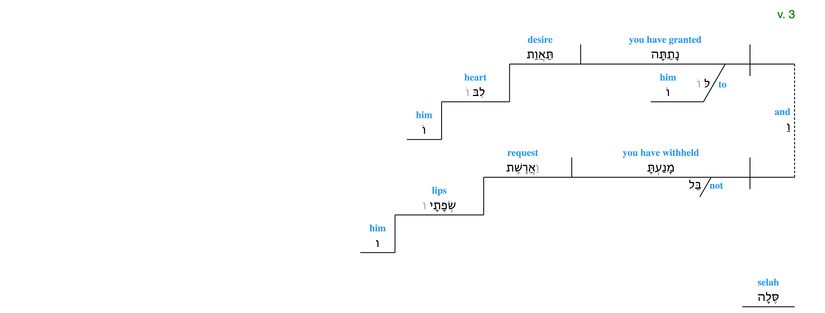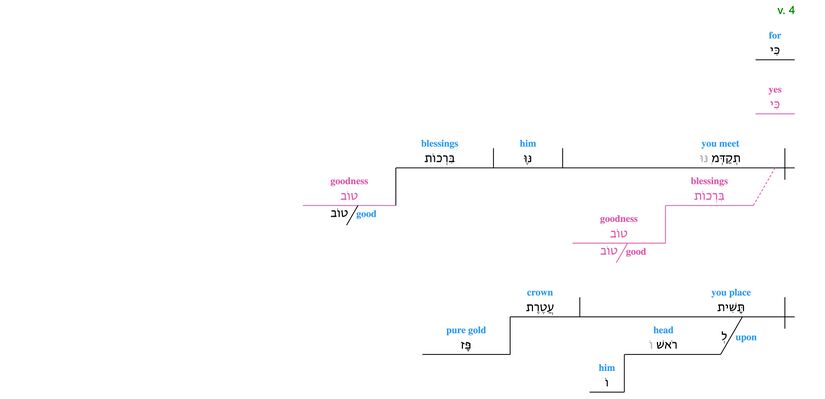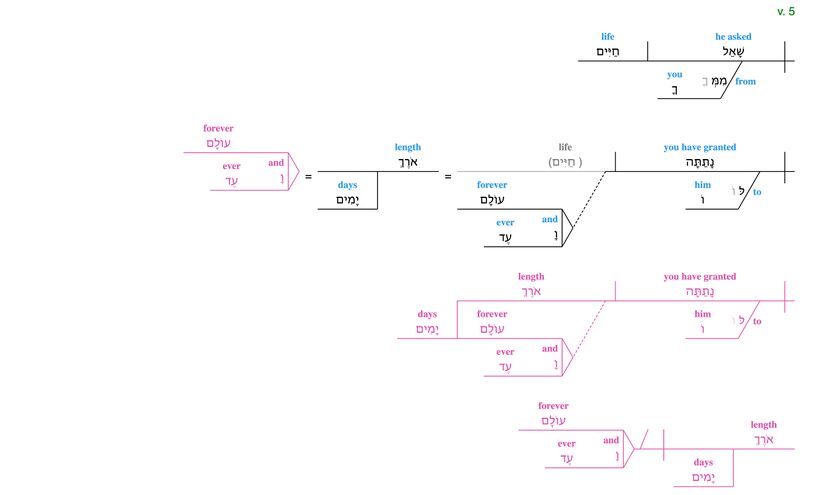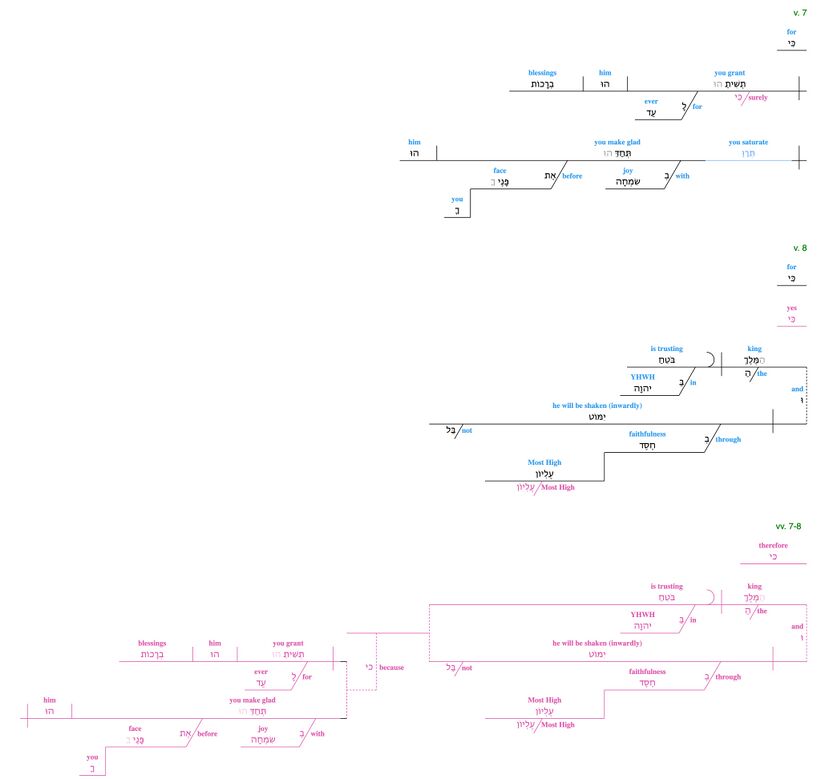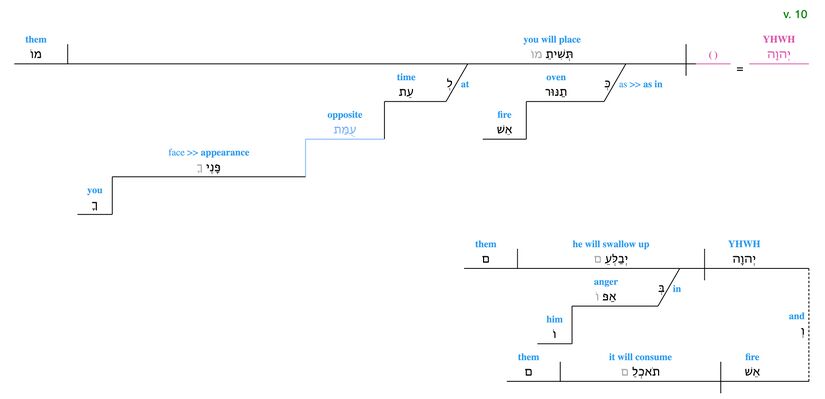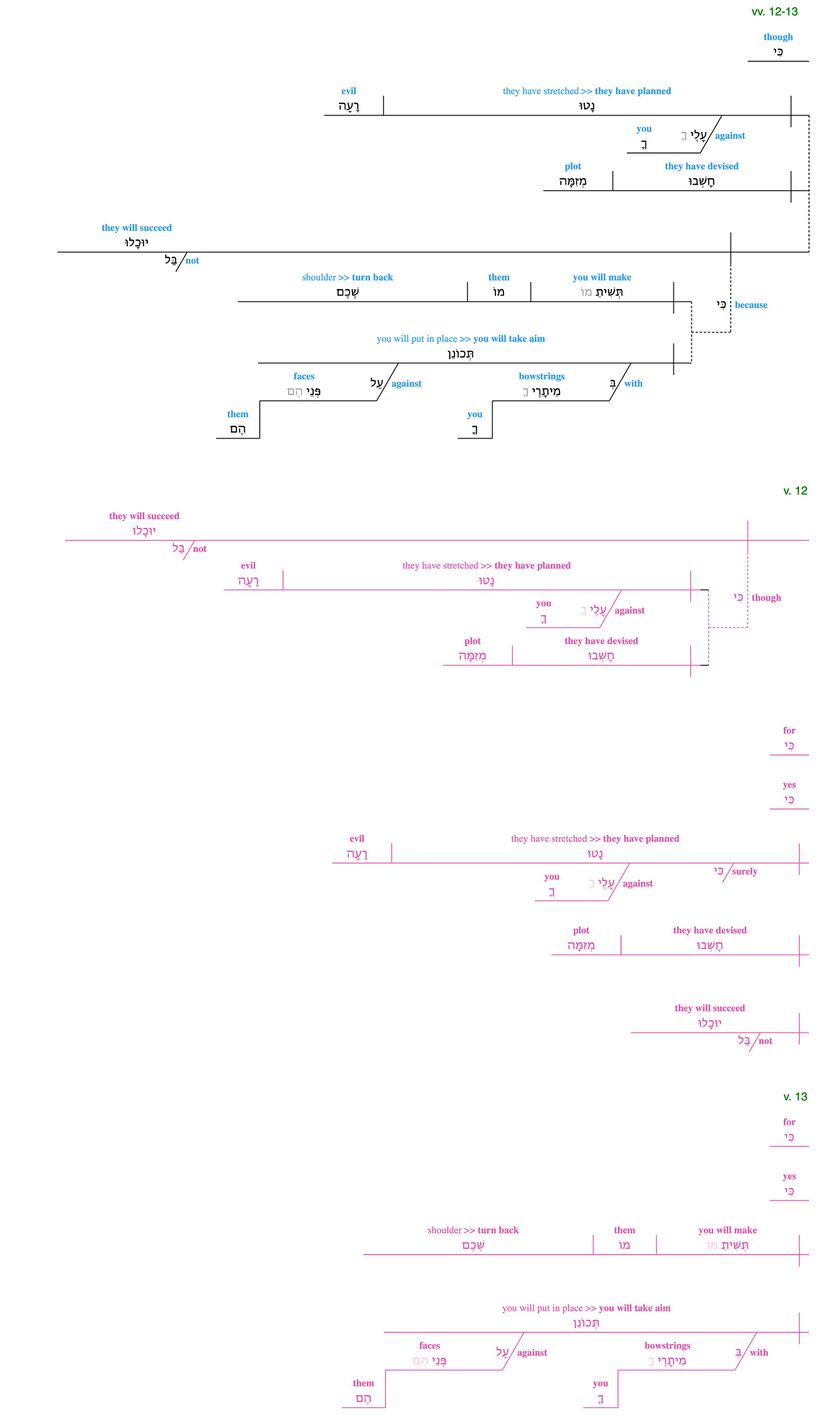Psalm 21 Grammar
About the Grammar Layer
The grammar layer visually represents the grammar and syntax of each clause. It also displays alternative interpretations of the grammar. (For more information, click "Expand" to the right.)
The grammatical diagram provides a way to visualise how different parts of a sentence work together. It represents the “surface-level” grammar, or morphosyntax, of a sentence. Morphosyntax includes both the form of words (morphology) and their placement in the sentence (syntax). This approach to visualising the text, based on the Reed-Kellogg diagramming method, places the grammatical subject in one slot, the verb in another slot, and modifiers and connectives in other slots.
For a detailed description of our method, see the Grammar Creator Guidelines.
Grammar Visuals for Psalm 21
| Visualization | Description |
|---|---|
| The clause is represented by a horizontal line with a vertical line crossing through it, separating the subject and the verb. | |
| The object is indicated by a vertical line that does not cross the horizontal line of the clause. Infinitives and participles may also have objects. If the direct object marker (d.o.m.) is present in the text, it appears in the diagram immediately before the object. If the grammar includes a secondary object, the secondary object will appear after the object, separated by another vertical line that does not cross the horizontal line of the clause. | |
| The subject complement follows the verb (often omitted in Hebrew) separated with a line leaning toward the right. It can be a noun, a whole prepositional phrase or an adjective. The later two appear modifying the complement slot. | |
| When a noun further describes or renames the object, it is an object complement. The object complement follows the object separated by a line leaning toward the right. | |
| In a construct chain, the noun in the absolute form modifies the noun in the construct form. | |
| Participles are indicated in whatever position in the clause they are in with a curved line before the participle. Participles can occur as nominal, where they take the place of a noun, predicate, where they take the place of a verb, or attributive, where they modify a noun or a verb similar to adjectives or adverbs. | |
| Infinitives are indicated by two parallel lines before the infinitive that cross the horizontal line. Infinitive constructs can appear as the verb in an embedded clause. Infinitive absolutes typically appear as an adverbial. | |
| The subject of the infinitive often appears in construct to it. In this situation, the infinitive and subject are diagrammed as a construct chain. | |
| The object of the infinitive is indicated by a vertical line that does not cross the horizontal line of the infinitival clause. | |
| Modifiers are represented by a solid diagonal line from the word they modify. They can attach to verbs, adjectives, or nouns. If modifying a verb or adjective, it is an adverb, but if modifying a noun, it is an adjective, a quantifier, or a definite article. If an adverb is modifying a modifier, it is connected to the modifier by a small dashed horizontal line. | |
| Adverbials are indicated by a dashed diagonal line extending to a horizontal line. These are nouns or infinitives that function adverbially (modifying either a verb or a participle), but are not connected by a preposition. | |
| Prepositional phrases are indicated by a solid diagonal line extending to a horizontal line. The preposition is to the left of the diagonal line and the dependent of the preposition is on the horizontal line. They can modify verbs (adverbial) or nouns (adjectival). | |
| Embedded clauses are indicated by a "stand" that looks like an upside-down Y. The stand rests in the grammatical position that the clause fulfills. Extending from the top of the stand is a horizontal line for the clause. If introduced by a complementizer, for example כִּי, the complementizer appears before the stand. Embedded clauses can stand in the place of any noun. | |
| When clauses are joined by a conjunction, they are compound clauses. These clauses are connected by a vertical dotted line. The conjunction is placed next to the dotted line. | |
| Within a clause, if two or more parts of speech are compound, these are represented by angled lines reaching to the two compound elements connected by a solid vertical line. If a conjunction is used, the conjunction appears to the left of the vertical line. Almost all parts of speech can be compound. | |
| Subordinate clauses are indicated by a dashed line coming from the line dividing the subject from the predicate in the independent clause and leading to the horizontal line of the subordinate clause. The subordinating conjunction appears next to the dashed line. | |
| Relative clauses also have a dashed line, but the line connects the antecedent to the horizontal line of the relative clause. The relative particle appears next to the dashed line. | |
| Sentence fragments are represented by a horizontal line with no vertical lines. They are most frequently used in superscriptions to psalms. They are visually similar to discourse particles and vocatives, but most often consist of a noun phrase (that does not refer to a person or people group) or a prepositional phrase. | |
| In the body of the psalm, a horizontal line by itself (with no modifiers or vertical lines) can indicate either a discourse particle or a vocative (if the word is a noun referring to a person or people group). A discourse particle is a conjunction or particle that functions at the discourse level, not at the grammatical level. Vocatives can appear either before or after the clause addressed to them, depending on the word order of the Hebrew. | |
| Apposition is indicated by an equal sign equating the two noun phrases. This can occur with a noun in any function in a sentence. |
| Hebrew text colors | |
|---|---|
| Default preferred text | The default preferred reading is represented by a black line. The text of the MT is represented in bold black text. |
| Dispreferred reading | The dispreferred reading is an alternative interpretation of the grammar, represented by a pink line. The text of the MT is represented in bold pink text, while emendations and revocalizations retain their corresponding colors (see below). |
| Emended text | Emended text, text in which the consonants differ from the consonants of the Masoretic text, is represented by bold blue text, whether that reading is preferred or dispreferred. |
| Revocalized text | Revocalized text, text in which only the vowels differ from the vowels of the Masoretic text, is represented by bold purple text, whether that reading is preferred or dispreferred. |
| (Supplied elided element) | Any element that is elided in the Hebrew text is represented by bold gray text in parentheses. |
| ( ) | The position of a non-supplied elided element is represented by empty black parentheses. For example, this would be used in the place of the noun when an adjective functions substantivally or in the place of the antecedent when a relative clause has an implied antecedent. |
| Gloss text colors | |
|---|---|
| Gloss used in the CBC | The gloss used in the Close-but-Clear translation is represented by bold blue text. |
| Literal gloss >> derived meaning | A gloss that shows the more literal meaning as well as the derived figurative meaning is represented in blue text with arrows pointing towards the more figurative meaning. The gloss used in the CBC will be bolded. |
| Supplied elided element | The gloss for a supplied elided element is represented in bold gray text. |
v. 1
- See our discussion of לַמְנַצֵחַ and the Translation Challenges.[1]
- The meaning of a psalm of David (לְדָוִד) in the superscription impacts whether David (who is not mentioned explicitly elsewhere in the psalm) should be attributed as the author. For further discussion of this issue see לְדָוִד.
v. 2
- There is a Ketiv/Qere issue in v. 2b with the Ketiv form יָגֵיל diagrammed as the preferred reading and the Qere יָגֶל as an emendation. The Qere reading could be based on an alternative root גלל and mean something like "to roll away". However, it seems best to understand the Qere form as an alternative form of יגיל, which, following the exclamation מה, has been naturally shortened with a decrease in tone into יָגֶל .[2] Because of this the Ketiv reading יָגֵיל with מַה retained has been kept as the preferred text. Therefore, the issue here is with vocalization and not meaning, with the Qere form rendering the same gloss "he exults". [3]
- In coming directly before the verbal clause here מַה is functioning to introduce and express the admiration of the verbal subject.[4]
v. 3
v. 4
- כי is treated as a particle coordinating at the discourse unit level here rather than a subordinating conjunction. Contextually its associated clause does not seem subordinate to the preceding or following clauses. Also the סֶּלָה "selah" just prior creates a discourse break. Some translations understand כי here to be functioning as an asseverative particle e.g. "Oui" ("Yes") (PDV2017, S21). See also vv. 8, 12, 13.
- The noun בִּרְכוֹת is in a construct chain with טוֹב an adjective; given the adjective is in the construct chain, it is considered as functioning nominally.
v. 5
- The construct phrase אֹרֶךְ יָמִים is treated in apposition to (חַיִּים) the implied object of נָתַ֣תָּה. While עוֹלָם וָעֶד are understood to function as accusatives of time and are diagrammed as a compound adverbial[5] see, ESV, NIV, NASB, and NKJV. An alternative suggestion is that עוֹלָם וָעֶד should be understood as "synonyms in apposition" rather than "accusatives of time."[6] The NET and CEV treat אֹרֶךְ יָמִים עוֹלָם וָעֶד as the direct object of נָתַתָּה as per the first alternative diagram. The NLT seems to understand אֹרֶךְ יָמִים עוֹלָם וָעֶד as a stand alone nominal clause "the days of his life stretch on forever," perhaps a more literal reading would be "the length of his days (are) forever and ever" see the second alternative diagram above (in pink).
v. 6
v. 7-8
- כי has been taken as a particle again here. However an alternative option has been diagrammed of modal adverb "surely" (NIV) as well as an alternative possibility where the two lines in v. 7 are understood to be subordinate to v. 8, the former providing the cause for what follows.
- שׁית (put) is in the category of verbs that can take a double object accusative.[7]
- A majority of English translations (ESV, NIV, NASB, NKJV etc.) appear to take אֶת as a preposition rather as the direct object identifier. A notable exception is the NLT. The latter is diagrammed as an alternative.
- HALOT suggests reading תְּחַדֵּ֥הוּ (a rare form in OT) as תְּרַוֵּהוּ from the root רוה "to saturate."[8]
v. 9
v. 10
- יהוה could be closing the first line or opening the second line. If considered part of the former it would be taken as a vocative, however as Craigie notes the "metrical balance" and clarity it provides when included with the latter line make that the preferred option.[9]
- The MT reading of לעת may be a corrupted form of לְעֻמַּת.[10] The MT text has been retained as the preferred reading in the diagram, though this will be an exegetical issue to investigate further.
v. 11
v. 12-13
- v. 12: The כִּי here is understood as concessive "even though."[11] The ESV, NIV, NLT, and NASB translate it this way. NET translates it as an emphatic modal adverb "yes", and others including NKJV as "for".
- v. 13: The כִּי in the preferred diagram is understood here as making v. 13 subordinate to v. 12 and functioning causally. Whereas in the second alternative for v. 12 and the alternative for v. 13 כִּי "for" is simply coordinating each line with what precedes.
- v. 13: The clause כִּי תְּשִׁיתֵמוֹ שֶׁכֶם can be understood with the תְּשִׁיתֵמוֹ having a double object including the pronominal suffix.[12] Also see the note for v. 10 above.
v. 14
Bibliography
- Arnold, Bill T., and John H. Choi. 2018. A Guide to Biblical Hebrew Syntax. Cambridge: Cambridge University Press.
- Briggs, Charles A., and Emilie Grace Briggs. 1906. A Critical and Exegetical Commentary on The Book of Psalms. Vol. I. New York, NY: C. Scribner’s sons.
- Craigie, Peter C. 2004. Word Biblical Commentary: Psalms 1–50. 2nd ed. Vol. 19. Nashville: Nelson Reference & Electronic.
- Dahood, Mitchell J. 1966. The Anchor Bible: Psalms I, 1-50. Garden City, NY: Doubleday.
- Davidson, A. B. 1902. The Analytical Hebrew and Chaldee Lexicon. Peabody, MA: Hendrickson.
- Davies, G. I. The Psalms. 1993. Sheffield, England: Sheffield Academic Press.
- Delitzsch, Franz Julius. 1883. A Commentary on the Psalms. New York: Funk and Wagnalls.
- Grogan, Geoffrey W. 1991. Expositor's Bible Commentary: Psalms. Grand Rapids, MI: Zondervan.
- Keel, Othmar. 1997. The Symbolism of the Biblical World: Ancient Near Eastern Iconography and the Book of Psalms. Translated by Timothy J. Hallett. Winona Lake: Eisenbrauns.
- Kraus, Hans-Joachim. 1993. A Continental Commentary. Psalms 1-59. Translated by Hilton C. Oswald. Minneapolis: Fortress Press.
- Ryken, Leland, James C. Wilhoit, and Tremper Longman III. 2000. Dictionary of Biblical Imagery. Downers Grove, IL: InterVarsity Press.
- Van der Merwe, Christo H. J., Jacobus A. Naudé, and Jan H. Kroeze. 2017. A Biblical Hebrew Reference Grammar. 2nd ed. New York: Bloomsbury T&T Clark.
- VanGemeren, Willem. 2008. Psalms: The Expositor's Bible Commentary. Grand Rapids: Zondervan.
- Waltke, Bruce K. & O'Connor, Michael. O. 1990. An Introduction to Biblical Hebrew Syntax. Winona Lake, IN: Eisenbrauns.
Footnotes
- ↑ In brief: לַמְנַצֵחַ belongs to a group all its own. There’s some debate as to the exact meaning of לַמְנַצֵחַ, but most think it means “to the chief musician/director of music/conductor”. Although both לַמְנַצֵחַ and לְדָוִד begin with lamed, the preposition has different functions in these two cases: we can read לַמְנַצֵחַ as “TO or FOR the musical director”, and לְדָוִד as “BY David”. The presence of לַמְנַצֵחַ often comes before technical musical and liturgical terms–the words that give translators the most trouble! This makes sense, as the musical director would have been a specialist in first Temple liturgy and would have been familiar with these words. It’s possible that the 55 psalms which include לַמְנַצֵחַ were meant to be performed only by Temple musicians, probably due to reasons of musical complexity or use in specific festivals.
- ↑ Delitzsch 1883, 219.
- ↑ "The Qere reading may be based on an alternative root גלל and mean something like "to roll away". However, it seems best to understand it as an alternative form of יגיל which, following the exclamation מה has been naturally shortened with a decrease in tone into יָגֶל" (Delitzsch 1883, 219). The interrogative מַה is not present in the LXX or Syriac (BHS) but has been kept as part of the preferred text here. Craigie notes that the Ketiv of the verb that follows is the more compatible reading if מַה is to be kept (Craigie 2004, 189).
- ↑ Van der Merwe 2017, 42.3.6 (4); Gesenius 1910, 471.
- ↑ HALOT, 859; Arnold-Choi 2018, 26.
- ↑ Dahood 2008, 132.
- ↑ Davidson 1902, §§.76, 78.
- ↑ DCH.
- ↑ Craigie 2004, 189 and 192.
- ↑ Craigie 2004, 189.
- ↑ HALOT, 471.
- ↑ Davidson 1902, 111.






















